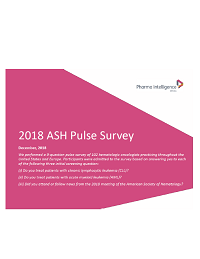Report Library
All Reports
2018 ASH Pulse Survey
January 02, 2019
This 9-question pulse survey of 102 hematologic oncologists practicing throughout the United States and Europe asks respondents their
thoughts on several topics presented at the 2018 American Society of Hematology (ASH) Annual Meeting including the use of Imbruvica in
front-line chronic lymphocytic leukemia (CLL), FLT3 inhibitors in acute myeloid leukemia (AML) and CAR-T therapy in CLL, multiple
myeloma and other indications.
Survey questions and additional resources are listed further below.
If you are a KOL Insight Subscriber, please access the survey from our KOL Insight portal (Subscribers only).
Biomedtracker will be offering KOL Reports and Physician Pulse Surveys for purchase a la carte, or access to all reports and surveys can be purchased as a subscription to KOL Insight. For more information on KOL Insight subscription, please email Biomedtracker or call Biomedtracker Client Services at (858) 200-2357.
For our disclosures, please read the Biomedtracker Research Standards.
Survey Questions:
If you are a KOL Insight Subscriber, please access the survey from our KOL Insight portal (Subscribers only).
Biomedtracker will be offering KOL Reports and Physician Pulse Surveys for purchase a la carte, or access to all reports and surveys can be purchased as a subscription to KOL Insight. For more information on KOL Insight subscription, please email Biomedtracker or call Biomedtracker Client Services at (858) 200-2357.
For our disclosures, please read the Biomedtracker Research Standards.
Survey Questions:
- Screening Questions: (i) Do you treat patients with chronic lymphocytic leukemia (CLL)? (ii) Do you treat patients with acute myeloid leukemia (AML)? (iii) Did you attend or follow news from the 2018 meeting of the American Society of Hematology?
- Q1. The iLLUMINATE Phase III trial in first-line CLL (65 or older/unfit) showed significantly longer mPFS for Imbruvica (ibrutinib) plus Gazyva (obinutuzumab) compared to chlorambucil plus Gazyva. Estimated 30-month progression-free survival was 79% (95% CI 70–85) in the Imbruvica plus Gazyva group and 31% (23–40) in the chlorambucil plus Gazyva group. Which regimen do you think will be the standard of care for first-line CLL treatment of older/unfit patients?
- Q2. In previously untreated CLL patients aged 70 years or younger, results from an NCI-sponsored Phase III study (E1912) showed that Imbruvica (ibrutinib) plus rituximab (IR) significantly improved PFS (HR: 0.35; 95% CI: 0.22-0.56) and OS (HR: 0.17; 95% CI: 0.05-0.54) compared to a chemotherapy regimen of fludarabine, cyclophosphamide, and rituximab (FCR). Which regimen do you think will be the standard of care for first-line CLL treatment of fit patients?
- Q3. In Quantum-R, a Phase III study comparing quizartinib to salvage chemotherapy in patients with R/R FLT3-ITD AML, there was a modest but significant improvement in OS (6.2 months vs 4.7 months, HR 0.758, p=0.0177). Please select the statement(s) that describe your attitude to FLT3 inhibitors (quizartinib, assuming it is approved, and Xospata/gilteritinib) for R/R AML.
- Q4. If quizartinib is approved, which FLT3 inhibitor would you recommend for R/R AML patients with an ITD mutation?
- Q5. Venclexta was approved with HMA or LDAC for treating newly-diagnosed AML unfit for intense chemo. With Venclexta combined with azacytidine, decitabine or LDAC, the CR/CRh rates were 61%, 62% and 42% respectively in a single-arm trial. Daurismo (glasdegib) was approved for the same indication with LDAC. Compared to LDAC alone, Daurismo extended OS by 4 months (8.3 months vs 4.3 months) with a HR of 0.46 (95% CI: 0.30, 0.71). Which regimen is likely to become the standard-of-care for this setting?
- Q6. CAR-T cells targeting BCMA are currently in development for multiple myeloma. If approved, do you think CAR-T cell therapy will be appropriate for transplant-ineligible multiple myeloma patients?
- Q7. A Phase I trial evaluated CTL119 CAR-T cells combined with Imbruvica in patients with poor prognosis R/R CLL. With 14 patients evaluable at 3 months, the ORR was 71.4% per iwCLL criteria (43% CR rate). A separate trial evaluated liso-cel (JCAR017) in the same setting. With 16 patients evaluable at 30 days the ORR was 75% (31.3% CR/CRi rate). Is CAR-T therapy too harsh for an indolent disease like CLL even if limited to multiply relapsed patients with poor prognosis?
- Q8. In which of the following indications do you think CAR-T therapies have the most clinical potential? Please rank them, with one being the indication where CAR-T therapies have the highest potential and nine being the indication where CAR-T therapies have the lowest potential.
- Q9. In which of the following indications do you think CD3 targeting bispecific antibodies have the most clinical potential? Please rank them, with one being the indication where bispecific antibodies have the highest potential and six being the indication where CAR-T therapies have the lowest potential.
| Disease Group Covered: | Oncology |
| Indications Covered: | Castleman's Disease |
Additional Resources:
